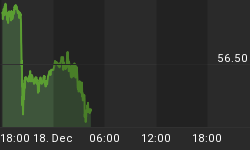The 10-Year Treasury Bond yield commanded our attention this past week, and we see it as one of the most important charts entering 2010. Why? Purely from a technical perspective, let's notice that three distinct instances in the past 12 months, yield pressed to 3.50% or lower, only to see an upside reversal back above 3.50% very quickly thereafter. In other words, the "beachball effect" kicks in under 3.50%. With the foregoing as a backdrop, let's also notice that yield has been declining since June even though nonfarm payrolls have been improving. My suspicion is that the upmove since the Dubai crisis low a week ago Friday, from 3.53% to 3.74% (+6%), might have been in anticipation of much improved payrolls data (an outlier number) and /or changing perceptions of climing inflation, climbing GDP, deficit-financning, etc. Whatever the case, from my perspective, long term Treasury yield -- and with it the ProShares UltraShort 20+ Year Treasury ETF (NYSE: TBT) -- is setting up for a potentially powerful advance in the days and weeks ahead.
That said, Friday's jobs data were better than expected, but far from suggesting an expansionary hiring period is directly ahead for U.S. businesses. Nonetheless, the key point is investor perceptions about the prospect of increasing business activity going forward, and therein the future of the Fed's zero interest rate policy (ZIRP). At the very least, Friday's market reaction suggests strongly that sooner rather than later, portfolios will have to be adjusted in anticipation of the end of ZIRP. Let's understand, though, that the adjustment is a process that will take time, but the timeframe has an initiation period, which is now. The enclosed chart shows this week's post-Dubai climb in 10-year yield of 30 bps (+8.5%), but let's notice that no technical damage has been inflicted on the June-December downtrend...yet. At this juncture, yield must climb and sustain above 3.88% (basis Dec. T-note futures) to damage the bearish chart pattern.
















